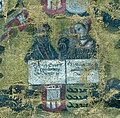Rudolf II (Werdenberg-Sargans)
Rudolf II. Count von Werdenberg-Sargans († 1322/23) came from a sideline of the Counts of Montfort of the dynasty of the Count Palatine of Tübingen .
Live and act
Rudolf II succeeded in increasing his property by marrying his heir Adelheid von Burgau . In 1289 he received the rule of Albeck , later he acquired Schmalegg and the bailiwick through the Pfäfers monastery . He also benefited from the fact that he was able to take over the entire inheritance of his father, Hartmann I , because his two brothers embarked on clerical careers. So Hartmann II is attested as Canon of Bamberg and Hugo III. as a Johanniterkomtur in Wädenswil and Bubikon . Presumably Rudolf II von Werdenberg-Sargans married a daughter of Egilolf, the baron of Aspermont, after the death of his first wife .
Throughout his life he had a close relationship with his cousin Hugo II von Werdenberg-Heiligenberg. Together with him, Rudolf II von Werdenberg-Sargans had already been a loyal follower of the first Habsburg King Rudolf I , but he was even closer to his son and successor Albrecht . He had known him since his youth and was knighted by him - together with his cousin - after the siege of the city of Wil in 1292. In general, the two Werdenbergers found themselves in the military campaigns of the Habsburgs with their followers, often among their former comrades-in-arms. In addition, they performed “police services” for the powerful sex, in which they captured political opponents and thus incapacitated them. The most prominent victims of this tactic were her relative Friedrich von Montfort , the bishop of Chur , in 1289 and Peter von Aspelt , the bishop of Basel and chancellor of Bohemia in 1304 . Rudolf II von Werdenberg-Sargans achieved great notoriety, especially through the second case, as his victim was appointed Archbishop of Mainz a short time later and thus also Imperial Chancellor , the highest office that a non-aristocrat could occupy at this time . Correspondingly, who was excommunicated Rudolf II. Von Werdenberg-Sargans imposed. However, this did not prevent him from continuing to exercise his rights and duties towards church institutions such as the Pfäfers monastery . Any other punishments for the act seem to have failed to materialize for the Count and his colleagues, despite numerous written reactions.
In 1312 Rudolf II von Werdenberg-Sargans left the dominions of Albeck (Langenau) and Aislingen to his son Heinrich, who then married Agnes von Württemberg in 1316 and thus gained the dominion of Trochtelfingen to his inheritance. After that, Rudolf II von Werdenberg-Sargans focused his own rule more on his own homeland. For this purpose, he also transferred some controversial claims to rule to the church in order to protect it from access by competing noble families. While his son Rudolf III, who died in 1325. like Heinrich concentrated on southern Germany, his younger two sons Hartmann III shared. zu Vaduz and Rudolf IV. zu Sargans the family's ancestral lands, which was recorded in writing on May 3, 1342 in Sargans after several years of joint rule . The distribution of the inheritance of Rudolf II von Werdenberg-Sargans is an indication that his older two sons came from his first marriage to Adelheid von Burgau, while the younger two sons are likely to be children of the unknown Aspermonterin.
A portrait of Rudolf II von Werdenberg-Sargans is preserved on the family tree of the Counts of Montfort in the Stuttgart Main State Archives. The depiction of Adelheid von Burgau with the Württemberg coat of arms, which was actually her great-grandfather, Count Ludwig III. von Württemberg (* 1166; † around 1241), shows that the historical interpretation of the portraits can be problematic. The creation of the painting can be dated to around 1720, at a time when the Montfort artist no longer knew exactly the historical facts. The artist called himself a “most obedient caplan”, but his name has worn off so badly that it is no longer legible.
literature
- Scott Brand: Count Rudolf II of Werdenberg-Sargans. A life marked by family strife and loyalty to the king. BOD, Norderstedt 2012.
- Fritz Rigendinger: The Sarganserland in the late Middle Ages. Local lordship, the County of Sargans and the Counts of Werdenberg-Sargans. Chronos, Zurich 2007.
Individual evidence
| personal data | |
|---|---|
| SURNAME | Rudolf II. |
| ALTERNATIVE NAMES | Rudolf II. Count von Werdenberg-Sargans (full name) |
| BRIEF DESCRIPTION | Count von Werdenberg-Sargans from the family of the Count Palatine of Tübingen |
| DATE OF BIRTH | 13th century or 14th century |
| DATE OF DEATH | around 1322 |




